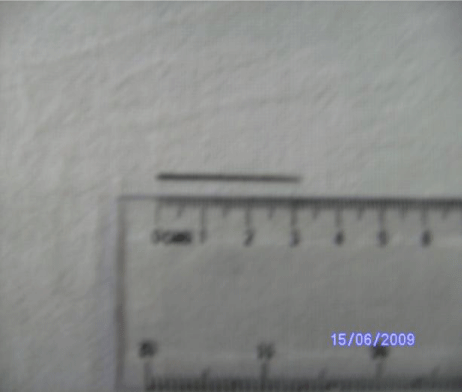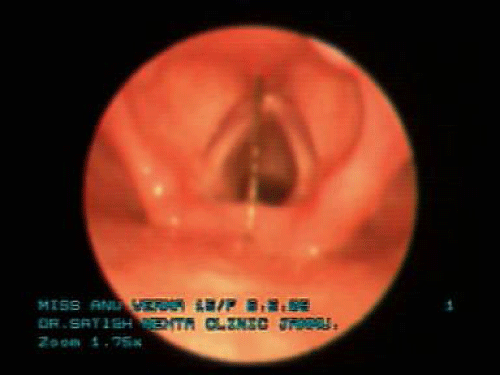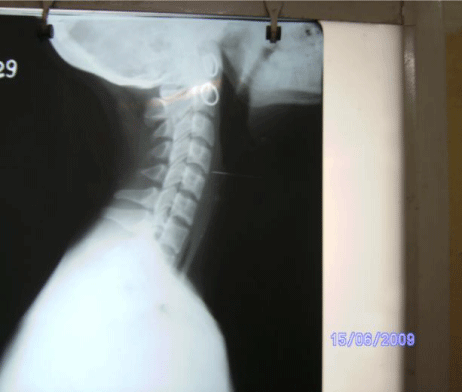An Interesting and Unusual Case of Embroidery Needle Impaction in the Larynx: A Case Report
Received: 18-Dec-2012 / Accepted Date: 03-Jan-2013 / Published Date: 07-Jan-2013 DOI: 10.4172/2161-119X.1000127
Abstract
Head and neck cancers are a common spectrum of diseases, accounting for over one-third of a million deaths worldwide each year, and over 11,000 annual US deaths. Most head and neck cancers have traditionally been diagnosed in older males who abuse tobacco and/or alcohol. With increasing public awareness of the dangers of tobacco exposure and excessive alcohol intake, the incidence of many subgroups of head and neck cancer is now decreasing in the West. However, over the past several decades, the rates of carcinomas of the tonsil and base of tongue are increasing, and are affecting a different demographic group consisting mainly of younger, nonsmoking, males. These lesions are caused by infections with the same high-risk human papillomaviruses (HPV) genotypes as those responsible for cervical cancer and other anogenital neoplasms. These HPV-induced head and neck cancers differ in their biology and prognosis from those neoplasms induced by tobacco or ethanol. Understanding the biology of these lesions will allow for the development of selective preventive and treatment strategies, and better outcomes, for this subpopulation of patients.
Introduction
The aspiration or ingestion of a foreign body into the upper aero digestive tract is a common accident that befalls children and adults alike. Sharp and pointed objects pose special problems. Laryngotracheal foreign bodies less common than bronchial foreign bodies are potentially dangerous. Commonly seen foreign bodies are coins, pencil tips, peas, beans, marbles and peanuts [1]. Various types of foreignbodies have been reported in the aero-digestive tract in literature. These have always posed a challenge to the ENT surgeon when impacted in the air passage especially in children since their airway lumen is very narrow, thus making instrumentation difficult [2]. Very few cases of a needle impaction in larynx have been reported. We present here a rare and an unusual case of impaction of Embroidery needle in supraglottis region in a critical position making its removal challenging.
Case Report
A 15 year old girl presented in ENT OPD of SMGS Hospital, with complaints of pain in throat after accidental inhalation of a needle two days before presentation while she was fiddling with it. The girl was not able to speak properly because of the pain. The girl did not tell the parents for two days for fear of inviting scold from parents. On examination, the girl was looking anxious but no signs of respiratory distress were present. With suspicion of foreign body in upper aerodigestive tract, indirect laryngoscopy was done and a shining metallic needle was seen in region just above the vocal cords extending anteroposterior in midline from just above anterior commissure to inter arytenoid region posteriorly. On doing fiberoptic laryngoscopy, we found the sharp end of the needle embedded anteriorly but its broad end with eye was slightly loose posteriorly. X-ray soft tissue neck also confirmed the needle in the region of glottis in larynx lying anteroposteriorly horizontally with its broad end posteriorly. The case was discussed with the Anesthetist regarding the risk of needle getting pushed in tracheobronchial tree during removal and consent for tracheostomy was taken for any impending airway compromise. Direct laryngoscope was put in larynx; needle was grasped with forceps and first dislodged from anterior end and then taken out rotating it transversely so that it does not slip through glottis. So the foreign body was removed without intubation and tracheostomy. Postoperative period was uneventful and patient discharged next day as the girl was symptom free.
Discussion
Foreign body inspiration occurs most often in the infants and children, and reports indicates that majority of the patients with this problem are children younger than five years. Foreign body aspiration can result in the airway compromise and sudden death and may lead to complications such as the bronchiectasis and recurrent or persistent pneumonia. So it is vital to diagnose and remove the foreign body promptly. Success with foreign body extraction depends upon the expertise of the bronchoscopist and anaesthetist. Extensive experience with foreign body aspiration is important because these patients tend to present with different problems. The team must always be ready for unexpected complications [3].
In adults, impaction is seen only in unconscious patients or those inebriated with alcohol, in mentally retarded persons, edentulous adults and to some other persons like electricians and decoration workers who hold these materials in between their teeth while working [4,5]. The majority of the foreign bodies of the airway pass through the glottis into the trachea and main bronchus so that larynx is not a common site of their lodgement. The foreign bodies with sticky or irregular shape may get lodged in the larynx. Foreign body inhalation is usually associated with significant coughing, choking, wheezing and gagging. These symptoms may pass unnoticed especially if the child is alone at the time of inhalation [5].
The rima glottidis being the narrowest part of the larynx tries to change the line of the foreign body in the anteroposterior direction. When a foreign body tries to pass down the vocal cords spasm, forced expiratory coughing forces the foreign body to lie in the supraglottis region. If coughing is forceful it may expel the foreign body out of the larynx. On the other hand if expiratory coughing is weak and resistance offered by the aryepiglottic folds is enough foreign body is held up in the vestibule of larynx [5].
Hussain et al. reported a case of open safety pin in the larynx in a six month old baby. The sharp end of the safety pin was upwards and had penetrated the anterior end of the left vocal fold. Tracheostomy was not required in this case and the child had an uneventful recovery [6].
Hathiram et al. reported a case of a 50 paise coin impacted in the adult larynx where the patient came to us 3 days later with the symptom of change of voice and pain in the throat but, surprisingly no dyspnea or stridor. As per the authors it is important to follow the dictum of never attempting to remove the foreign-body without first confirming and documenting its presence and then making sure that one has proper illumination, instrumentation and expertise to successfully remove it. A lack of these and undue haste may sometimes prove to be fatal [2].
Chen et al. reported an unusual case of laryngeal foreign body in an infant masquerading as laryngeal web in its clinical presentation as well as radiological findings. The diagnosis was only made at endoscopy, thus emphasizing the limited sensitivity of radiographic studies in identifying this condition [7].
In our case foreign body was seen just above the vocal cords anteroposteriorly with its sharp end embedded anteriorly just above the anterior commissure and blunt end with eye posteriorly in the interarytenoid region. The needle was removed by carefully disimpacting the needle anteriorly and then rotating it transversely (so that even if it slips it does not cross glottis) to take it out safely through Direct laryngoscope (Figure 1).
As per our experience foreign body anywhere in the airway, has to be first confirmed of its site of impaction with the help of radiological and endoscopic examination so that the approach for removal of foreign body is clearly outlined before the actual procedure (Figures 2 and 3). This helps in avoiding the undue complications which may hamper the outcome, as upper airway has a very limited room for manipulation if the foreign body is lodged in the glottis. Any error on the part of surgeon can lead to laryngeal edema and may prove fatal.
Conclusion
Although most of the foreign bodies lodged in the larynx can be removed safely by direct laryngoscopy, either under local anesthesia or under general anesthesia. But in cases like this one where foreign body is lodged right in the place from where endotracheal tube has to be inserted for securing the airway, decision has to be taken cautiously and patient be informed of the tracheostomy beforehand, which may be required in some cases. Moreover the removal should be done by an experienced otolaryngologist in association with experienced anaesthetist keeping in view the resultant complications associated with such cases arising out of foreign body slipping in tracheobronchial tree.
Sometimes the children may not inform the parents for fear of inviting scold as observed in our case, but such behavior has to be discouraged in children and the parents should take their children in confidence so that they immediately report such life threatening conditions.
References
- Bakshi J, Mann SBS, Gupta AK (2007) Unusual presentation of the laryngeal foreign bodies-report of two rare cases. Indian J Otolaryngol Head Neck Surg59: 252-254.
- Hathiram BT, Khattar V, Hiwarkar S, Rai R (2011) An unusual presentation of impacted foreign body in the adult larynx. Indian J Otolaryngol Head Neck Surg 63: 96-98.
- Soysal O, Kuzucu A, Ulutas H (2006) Tracheobronchial foreign body aspiration: A continuing challenge. Otolaryngol Head Neck Surg 135: 223-226.
- Gautam BS, Abrol R, Dass A (2005) An unusual foreign body in the larynx in an adult. Otolaryngol Head Neck Surg 133: 639.
- Mundra RK, Gupta SK, Mishra C, Bandi A (1989) Unusual foreign body of the larynx. Ind J Otolaryngol Head Neck Surg 41:152-153.
- Hussain SS, Raine CH, Caldicott LD, Wade MJ (1994) An open safety pin in the larynx: A case report. J Laryngol Otol 108: 254-255.
- Chen YT, Singh R, Brett RH (1998) Diagnostic red herring in an infant with stridor. Singapore Med J 39: 471-472.
Citation: Sunil Kumar (2013) An Interesting and Unusual Case of Embroidery Needle Impaction in the Larynx: A Case Report. Otolaryngology 3:127. DOI: 10.4172/2161-119X.1000127
Copyright: © 2013 Sunil Kumar, et al. This is an open-access article distributed under the terms of the Creative Commons Attribution License, which permits unrestricted use, distribution, and reproduction in any medium, provided the original author and source are credited.
Select your language of interest to view the total content in your interested language
Share This Article
Recommended Journals
Open Access Journals
Article Tools
Article Usage
- Total views: 15141
- [From(publication date): 5-2013 - Nov 13, 2025]
- Breakdown by view type
- HTML page views: 10406
- PDF downloads: 4735



